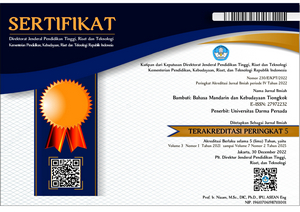The Comparative Language Style at SOT and SOT’s Subtitle on Soft News DAAI Mandarin and Metro Xinwen
Komparatif Gaya Bahasa Pada SOT dan Takarir SOT Soft News DAAI Mandarin dan Metro Xinwen
Abstract
Nowadays, language style has entered a wider scope, included electronic journalism and also television news broadcast. This paper described and used language style according to Huang and friends (2012). This paper will discussed about the comparison of language style at soundbite on tape (SOT) and SOT’s subtitle on both soft news videos, is: DAAI Mandarin and Metro Xinwen. This paper’s goals is to find out the type of language style that contained in SOT and SOT’s subtitle on soft news DAAI Mandarin and Metro Xinwen. Data source using soft news video of television news broadcast. Research method used descriptive qualitative with observed data collection methods and note taking techniques for the data collection. The result of data analysis used three steps, is: data condensation, data presenting, and drawing conclusions. The results of data analysis are presented in the form of narrative explanation.

This work is licensed under a Lisensi Creative Commons Atribusi 4.0 Internasional.
Authors who publish with this journal agree to the following terms:
- Authors retain copyright and grant the journal right of first publication with the work simultaneously licensed under a Lisensi Creative Commons Atribusi 4.0 Internasional that allows others to share the work with an acknowledgment of the work's authorship and initial publication in this journal.
- Authors are able to enter into separate, additional contractual arrangements for the non-exclusive distribution of the journal's published version of the work (e.g., post it to an institutional repository or publish it in a book), with an acknowledgment of its initial publication in this journal.
- Authors are permitted and encouraged to post their work online (e.g., in institutional repositories or on their website) prior to and during the submission process, as it can lead to productive exchanges, as well as earlier and greater citation of published work (See The Effect of Open Access).









